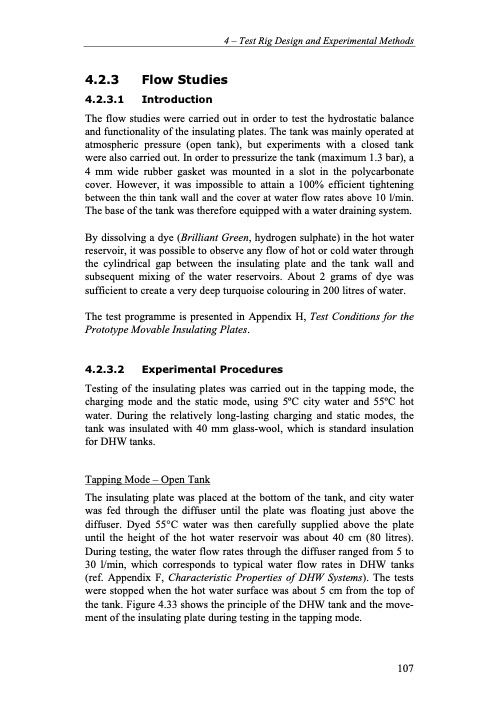
PDF Publication Title:
Text from PDF Page: 129
4 – Test Rig Design and Experimental Methods 4.2.3 Flow Studies 4.2.3.1 Introduction The flow studies were carried out in order to test the hydrostatic balance and functionality of the insulating plates. The tank was mainly operated at atmospheric pressure (open tank), but experiments with a closed tank were also carried out. In order to pressurize the tank (maximum 1.3 bar), a 4 mm wide rubber gasket was mounted in a slot in the polycarbonate cover. However, it was impossible to attain a 100% efficient tightening between the thin tank wall and the cover at water flow rates above 10 l/min. The base of the tank was therefore equipped with a water draining system. By dissolving a dye (Brilliant Green, hydrogen sulphate) in the hot water reservoir, it was possible to observe any flow of hot or cold water through the cylindrical gap between the insulating plate and the tank wall and subsequent mixing of the water reservoirs. About 2 grams of dye was sufficient to create a very deep turquoise colouring in 200 litres of water. The test programme is presented in Appendix H, Test Conditions for the Prototype Movable Insulating Plates. 4.2.3.2 Experimental Procedures Testing of the insulating plates was carried out in the tapping mode, the charging mode and the static mode, using 5oC city water and 55oC hot water. During the relatively long-lasting charging and static modes, the tank was insulated with 40 mm glass-wool, which is standard insulation for DHW tanks. Tapping Mode – Open Tank The insulating plate was placed at the bottom of the tank, and city water was fed through the diffuser until the plate was floating just above the diffuser. Dyed 55°C water was then carefully supplied above the plate until the height of the hot water reservoir was about 40 cm (80 litres). During testing, the water flow rates through the diffuser ranged from 5 to 30 l/min, which corresponds to typical water flow rates in DHW tanks (ref. Appendix F, Characteristic Properties of DHW Systems). The tests were stopped when the hot water surface was about 5 cm from the top of the tank. Figure 4.33 shows the principle of the DHW tank and the move- ment of the insulating plate during testing in the tapping mode. 107PDF Image | Residential CO2 Heat Pump System for Combined

PDF Search Title:
Residential CO2 Heat Pump System for CombinedOriginal File Name Searched:
20559406.pdfDIY PDF Search: Google It | Yahoo | Bing
CO2 Organic Rankine Cycle Experimenter Platform The supercritical CO2 phase change system is both a heat pump and organic rankine cycle which can be used for those purposes and as a supercritical extractor for advanced subcritical and supercritical extraction technology. Uses include producing nanoparticles, precious metal CO2 extraction, lithium battery recycling, and other applications... More Info
Heat Pumps CO2 ORC Heat Pump System Platform More Info
| CONTACT TEL: 608-238-6001 Email: greg@infinityturbine.com | RSS | AMP |